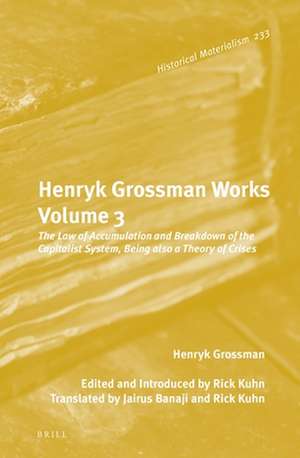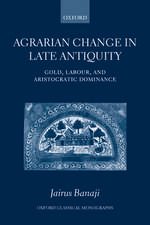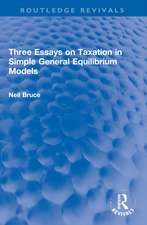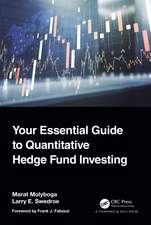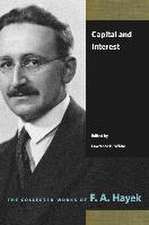Henryk Grossman Works, Volume 3: The Law of Accumulation and Breakdown of the Capitalist System, Being also a Theory of Crises: Historical Materialism Book Series, cartea 233
Autor Henryk Grossman Editat de Rick Kuhn Traducere de Jairus Banajien Limba Engleză Hardback – 3 noi 2021
Din seria Historical Materialism Book Series
-
 Preț: 215.03 lei
Preț: 215.03 lei - 18%
 Preț: 966.97 lei
Preț: 966.97 lei - 18%
 Preț: 990.17 lei
Preț: 990.17 lei - 18%
 Preț: 1092.16 lei
Preț: 1092.16 lei - 18%
 Preț: 1229.68 lei
Preț: 1229.68 lei - 18%
 Preț: 1241.69 lei
Preț: 1241.69 lei - 18%
 Preț: 1190.02 lei
Preț: 1190.02 lei - 18%
 Preț: 893.05 lei
Preț: 893.05 lei - 18%
 Preț: 1401.90 lei
Preț: 1401.90 lei - 18%
 Preț: 928.61 lei
Preț: 928.61 lei - 18%
 Preț: 690.93 lei
Preț: 690.93 lei -
 Preț: 268.72 lei
Preț: 268.72 lei - 18%
 Preț: 674.66 lei
Preț: 674.66 lei - 18%
 Preț: 606.89 lei
Preț: 606.89 lei - 18%
 Preț: 783.83 lei
Preț: 783.83 lei - 18%
 Preț: 584.79 lei
Preț: 584.79 lei - 18%
 Preț: 711.88 lei
Preț: 711.88 lei - 18%
 Preț: 653.06 lei
Preț: 653.06 lei - 18%
 Preț: 531.92 lei
Preț: 531.92 lei - 18%
 Preț: 618.25 lei
Preț: 618.25 lei - 18%
 Preț: 647.76 lei
Preț: 647.76 lei - 18%
 Preț: 710.71 lei
Preț: 710.71 lei - 18%
 Preț: 922.25 lei
Preț: 922.25 lei - 18%
 Preț: 810.75 lei
Preț: 810.75 lei - 18%
 Preț: 996.79 lei
Preț: 996.79 lei - 18%
 Preț: 815.23 lei
Preț: 815.23 lei - 18%
 Preț: 1506.61 lei
Preț: 1506.61 lei - 18%
 Preț: 852.64 lei
Preț: 852.64 lei - 18%
 Preț: 645.67 lei
Preț: 645.67 lei - 18%
 Preț: 781.47 lei
Preț: 781.47 lei - 18%
 Preț: 615.24 lei
Preț: 615.24 lei - 18%
 Preț: 1155.48 lei
Preț: 1155.48 lei - 18%
 Preț: 1063.00 lei
Preț: 1063.00 lei - 18%
 Preț: 867.10 lei
Preț: 867.10 lei - 48%
 Preț: 1092.66 lei
Preț: 1092.66 lei - 36%
 Preț: 765.88 lei
Preț: 765.88 lei - 18%
 Preț: 648.19 lei
Preț: 648.19 lei - 18%
 Preț: 759.38 lei
Preț: 759.38 lei - 18%
 Preț: 716.43 lei
Preț: 716.43 lei - 18%
 Preț: 671.15 lei
Preț: 671.15 lei - 18%
 Preț: 671.56 lei
Preț: 671.56 lei - 18%
 Preț: 760.94 lei
Preț: 760.94 lei - 18%
 Preț: 1012.79 lei
Preț: 1012.79 lei - 18%
 Preț: 817.26 lei
Preț: 817.26 lei - 18%
 Preț: 656.87 lei
Preț: 656.87 lei - 18%
 Preț: 1298.20 lei
Preț: 1298.20 lei - 18%
 Preț: 791.88 lei
Preț: 791.88 lei - 18%
 Preț: 971.69 lei
Preț: 971.69 lei - 18%
 Preț: 635.15 lei
Preț: 635.15 lei
Preț: 959.97 lei
Preț vechi: 1170.70 lei
-18% Nou
Puncte Express: 1440
Preț estimativ în valută:
183.71€ • 191.09$ • 151.67£
183.71€ • 191.09$ • 151.67£
Carte indisponibilă temporar
Doresc să fiu notificat când acest titlu va fi disponibil:
Se trimite...
Preluare comenzi: 021 569.72.76
Specificații
ISBN-13: 9789004351974
ISBN-10: 9004351973
Dimensiuni: 155 x 235 mm
Greutate: 0.95 kg
Editura: Brill
Colecția Brill
Seria Historical Materialism Book Series
ISBN-10: 9004351973
Dimensiuni: 155 x 235 mm
Greutate: 0.95 kg
Editura: Brill
Colecția Brill
Seria Historical Materialism Book Series
Cuprins
Acknowledgements
List of Figures and Tables
Editor’s Introduction
Rick Kuhn
Context
Grossman’s Argument
Initial Reception, Translations, Republications and Later Literature
Criticisms and Responses
Conventions
Introduction
1 The Downfall of Capitalism in Previous Discussions
1The Points at Issue
2The Conception of Breakdown in Previous Literature
3The Final Abandonment of Marx’s Theory of Accumulation and Breakdown by Karl Kautsky
2 The Law of Capitalist Breakdown
1Is There a Theory of Breakdown in Marx?
2Preliminary Methodological Remarks. Economic Coordinate System: The Necessity of Simplifying Assumptions; The Assumption of Constant Prices as the Starting Point for the Analysis (Constant Value of Money; Equilibrium State of the Capitalist Mechanism, under Which Prices Coincide with Values; Exclusion of Competition)
3The Equilibrium Theory of the Neo-harmonists. Otto Bauer’s Reproduction Schema
4The Conditions and Tasks of the Analysis Using the Schema
5Why Were the Classical Economists Disquieted by the Fall in the Rate of Profit. Despite Growth in the Mass of Profit?
6The Views of the Classical Economists on the Future of Capitalism, Ricardo. and John Stuart Mill
7Marx’s Theory of Accumulation and Breakdown
8Marx’s Theory of Breakdown Is Simultaneously a Theory of Crisis
9An Anti-Critical Interlude
10The Logical and Mathematical Basis of the Law of Breakdown
11Causes of the Misunderstanding of Marx’s Theory of Accumulation and Breakdown
12The Factors of the Breakdown Tendency. The Problem of the Periodicity of Crises. The Course of the Cycle and the Problem of Establishing the Duration of Its Phases – The Cycle Research Institutes’ Symptomatology. – The Provisional Exclusion of Credit. – The Tempo of Capital Accumulation (in the Upswing) and the Extent of Population Growth
13The Crisis and Underconsumption Theory. – Incorporating Credit into the Analysis. – The Cycle within the ‘Three Markets’: The Impetus to the Boom within the Sphere of Production (Business). The Spillover of the Wave Movement from Production into the Money Market (Money), Finally to the Stock Exchange (Speculation)
14The Elasticity of Accumulation. The Problem of Sudden Leaps and One-Sided Development in Individual Branches of Production. The Relationship between the Extent of the Apparatus of Production and the Extent of Sales Turnover
15Fetters on the Development of the Productive Forces under Capitalism
16Marx’s Theory of Insufficient Valorisation Due to Overaccumulation and Luxemburg’s Theory of the Impossibility of ‘Realising Surplus Value’ under Capitalism
3 Modifying Countertendencies
Verification of the Abstract Theoretical Analysis by Concrete Appearances of Capitalist Reality
1Restoring Profitability through Internal Structural Changes in the Mechanism of Capitalist Countries
2The World Market
Concluding Observations
1The Breakdown Tendency and the Class Struggle (Marx’s Theory of Wages. The Factors That Determine the Wages. The Historical Tendency of Wage Levels. The Class Struggle and the Final Goal)
2The Collapse of Capitalism and the General Cartel
Appendix: Corrections of Grossman’s Calculations
References
Index, including Abbreviations and Micro Biographies
List of Figures and Tables
Editor’s Introduction
Rick Kuhn
Context
Grossman’s Argument
Initial Reception, Translations, Republications and Later Literature
Criticisms and Responses
Conventions
Introduction
1 The Downfall of Capitalism in Previous Discussions
1The Points at Issue
2The Conception of Breakdown in Previous Literature
3The Final Abandonment of Marx’s Theory of Accumulation and Breakdown by Karl Kautsky
2 The Law of Capitalist Breakdown
1Is There a Theory of Breakdown in Marx?
2Preliminary Methodological Remarks. Economic Coordinate System: The Necessity of Simplifying Assumptions; The Assumption of Constant Prices as the Starting Point for the Analysis (Constant Value of Money; Equilibrium State of the Capitalist Mechanism, under Which Prices Coincide with Values; Exclusion of Competition)
3The Equilibrium Theory of the Neo-harmonists. Otto Bauer’s Reproduction Schema
4The Conditions and Tasks of the Analysis Using the Schema
5Why Were the Classical Economists Disquieted by the Fall in the Rate of Profit. Despite Growth in the Mass of Profit?
6The Views of the Classical Economists on the Future of Capitalism, Ricardo. and John Stuart Mill
7Marx’s Theory of Accumulation and Breakdown
8Marx’s Theory of Breakdown Is Simultaneously a Theory of Crisis
9An Anti-Critical Interlude
10The Logical and Mathematical Basis of the Law of Breakdown
11Causes of the Misunderstanding of Marx’s Theory of Accumulation and Breakdown
12The Factors of the Breakdown Tendency. The Problem of the Periodicity of Crises. The Course of the Cycle and the Problem of Establishing the Duration of Its Phases – The Cycle Research Institutes’ Symptomatology. – The Provisional Exclusion of Credit. – The Tempo of Capital Accumulation (in the Upswing) and the Extent of Population Growth
13The Crisis and Underconsumption Theory. – Incorporating Credit into the Analysis. – The Cycle within the ‘Three Markets’: The Impetus to the Boom within the Sphere of Production (Business). The Spillover of the Wave Movement from Production into the Money Market (Money), Finally to the Stock Exchange (Speculation)
14The Elasticity of Accumulation. The Problem of Sudden Leaps and One-Sided Development in Individual Branches of Production. The Relationship between the Extent of the Apparatus of Production and the Extent of Sales Turnover
15Fetters on the Development of the Productive Forces under Capitalism
16Marx’s Theory of Insufficient Valorisation Due to Overaccumulation and Luxemburg’s Theory of the Impossibility of ‘Realising Surplus Value’ under Capitalism
3 Modifying Countertendencies
Verification of the Abstract Theoretical Analysis by Concrete Appearances of Capitalist Reality
1Restoring Profitability through Internal Structural Changes in the Mechanism of Capitalist Countries
2The World Market
Concluding Observations
1The Breakdown Tendency and the Class Struggle (Marx’s Theory of Wages. The Factors That Determine the Wages. The Historical Tendency of Wage Levels. The Class Struggle and the Final Goal)
2The Collapse of Capitalism and the General Cartel
Appendix: Corrections of Grossman’s Calculations
References
Index, including Abbreviations and Micro Biographies
Notă biografică
Henryk Grossman (1881–1950) was the preeminent Marxist economist of the twentieth century. He was the founding theoretician and secretary of the Jewish Socialist Party of Galicia; a Professor at the Free University of Warsaw; then, as a member of the Institute for Social Research, at the University of Frankfurt; and later at the University of Leipzig.
Rick Kuhn is a member of Socialist Alternative in Australia. In addition to numerous other publications, he wrote the Deutscher Prize winning biography Henryk Grossman and the Recovery of Marxism (University of Illinois Press, 2008), co-authored Labor's Conflict: Big Business, Workers and the Politics of Class (Cambridge, 2011) and edited Class and Struggle in Australia (Pearson, 2005).
Rick Kuhn is a member of Socialist Alternative in Australia. In addition to numerous other publications, he wrote the Deutscher Prize winning biography Henryk Grossman and the Recovery of Marxism (University of Illinois Press, 2008), co-authored Labor's Conflict: Big Business, Workers and the Politics of Class (Cambridge, 2011) and edited Class and Struggle in Australia (Pearson, 2005).
